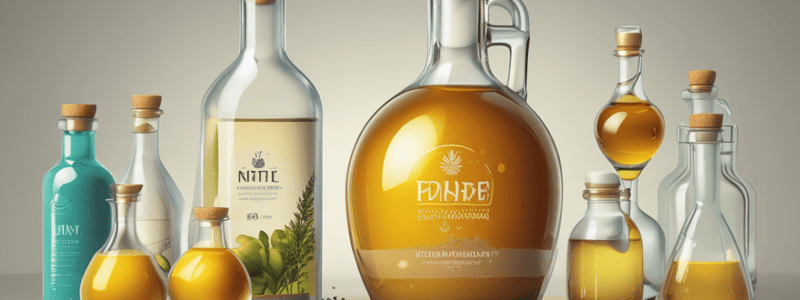Podcast
Questions and Answers
What is the main characteristic of edible oils?
What is the main characteristic of edible oils?
- They are only used for baking.
- They are solid at room temperature.
- They are liquid at room temperature. (correct)
- They are only derived from animals.
What is the primary use of edible oils?
What is the primary use of edible oils?
- Salad dressings
- Baking
- Cooking
- All of the above (correct)
Which of the following is an example of an edible fat?
Which of the following is an example of an edible fat?
- Sunflower oil
- Butter (correct)
- Soybean oil
- Olive oil
Which region is a leading producer of palm oil?
Which region is a leading producer of palm oil?
What is a factor that influences the production numbers of edible oils?
What is a factor that influences the production numbers of edible oils?
Which of the following is a key producer of soybean oil?
Which of the following is a key producer of soybean oil?
Why do oils with lower smoke points better suit low-heat cooking?
Why do oils with lower smoke points better suit low-heat cooking?
What is indicated by an oil's smoke point?
What is indicated by an oil's smoke point?
What can occur when oils are heated beyond their smoke point?
What can occur when oils are heated beyond their smoke point?
Why is it important to cook with an oil below its smoke point?
Why is it important to cook with an oil below its smoke point?
What type of fatty acids are typically found in oils with higher smoke points?
What type of fatty acids are typically found in oils with higher smoke points?
Which type of cooking method is suitable for oils with higher smoke points?
Which type of cooking method is suitable for oils with higher smoke points?
What is a characteristic of oils with lower smoke points?
What is a characteristic of oils with lower smoke points?
What happens to the fatty acids in oil when it oxidizes?
What happens to the fatty acids in oil when it oxidizes?
What is the primary method used to extract oil from olive and palm seeds?
What is the primary method used to extract oil from olive and palm seeds?
Which two products are yielded from the oil extraction process?
Which two products are yielded from the oil extraction process?
What is the purpose of solvent extraction in oil production?
What is the purpose of solvent extraction in oil production?
Which of the following is NOT a method of oil extraction?
Which of the following is NOT a method of oil extraction?
What is the advantage of using mechanical pressing for oil extraction?
What is the advantage of using mechanical pressing for oil extraction?
Which of the following oils is often extracted using a combination of pressing and solvent extraction?
Which of the following oils is often extracted using a combination of pressing and solvent extraction?
What is the result of combining mechanical pressing and solvent extraction?
What is the result of combining mechanical pressing and solvent extraction?
What is the by-product of oil extraction that is high in protein?
What is the by-product of oil extraction that is high in protein?
Flashcards are hidden until you start studying
Study Notes
Common Sources of Edible Oil
- Palm Oil: Extracted from oil palms, used in food products, detergents, cosmetics, and biofuels.
- Soybean Oil: Derived from soybeans, widely used in cooking and industrial applications.
- Canola Oil: Obtained from canola plant seeds, known for its low saturated fat content.
- Olive Oil: Extracted from olives, highly valued for its flavor and health benefits, particularly in Mediterranean cuisine.
- Sunflower Oil: Comes from sunflower seeds, appreciated for its light taste and high vitamin E content.
- Coconut Oil: Sourced from coconut meat, used in cooking, cosmetics, and medicinal products.
- Corn Oil: Derived from corn kernels, often used in frying due to its high smoke point.
Edible Oil Extraction Methods
- Pressing: A mechanical process used to squeeze oil out of seeds or soft fruit endosperm, commonly used for olive and palm oil.
- Solvent Extraction: A chemical process that uses a solvent to separate oil from seed meal, often used in combination with pressing for higher oil yield.
Definition of Edible Oils and Fats
- Edible Oils: Fats that are liquid at room temperature, extracted from various plants, used in cooking, baking, and as salad dressings.
- Edible Fats: Fats that are solid or semi-solid at room temperature, often derived from animals, but also include plant-based fats like coconut oil and palm oil.
World Edible Oil Production Data (as of 2023)
- Global production of edible oils has been increasing over the years due to growing demand.
- Major contributors to world production are palm oil, soybean oil, and canola oil.
- Asia, particularly Indonesia and Malaysia, are leading producers of palm oil.
- The United States, Brazil, and Argentina are key producers of soybean oil.
Factors Affecting Edible Oil Quality
- Fatty acids in oil can oxidize, producing harmful free radicals.
- Cooking Performance: Oils with higher smoke points are more stable at high temperatures, making them suitable for high-heat cooking methods.
- Chemical Stability: The smoke point is an indicator of an oil's chemical stability, with more stable oils resisting oxidative damage for longer periods when heated.
- Health Concerns: The breakdown products of oils at high temperatures can include trans fats and other compounds detrimental to health.
Fatty Acid Composition and Smoke Point of Vegetable Oils
- Canola Oil: Low in saturated fats (10%), moderate in monounsaturated and polyunsaturated fats, with a smoke point of 420°F (216°C).
- Cottonseed Oil: Higher in saturated fats (25.900%), excellent for frying, with a smoke point of 437°F (225°C).
- Safflower Oil: Very low in saturated fats (8%), low in monounsaturated fats, moderate in polyunsaturated fats, with a smoke point of 400°F (204°C).
- Olive Oil: Moderate in saturated fats (14%), high in monounsaturated fats, with a smoke point of 410°F (210°C).
- Soybean Oil: Moderate in saturated fats, moderate in monounsaturated fats, moderate in polyunsaturated fats, with a smoke point of 410°F (210°C).
Studying That Suits You
Use AI to generate personalized quizzes and flashcards to suit your learning preferences.




